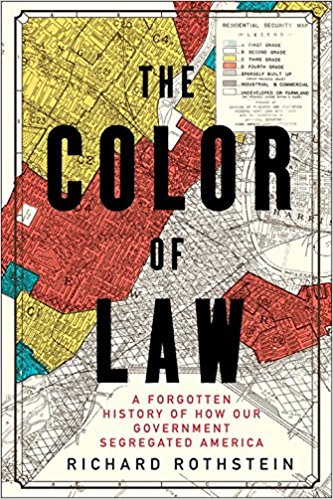
“We have created a caste system in this country, with African Americans kept exploited and geographically separate by racially explicit government policies.” So writes Richard Rothstein in The Color of Law: A Forgotten History of How Our Government Segregated America. That’s a strong statement. But Rothstein, a research associate of the Economic Policy Institute (EPI) and a fellow at the Thurgood Marshall Institute of the NAACP Legal Defense Fund, provides much support for his claim. He shows how racist Federal Housing Administration (FHA) policies on mortgages, exclusionary zoning laws, state real estate regulations, geographic placement of government schools, urban renewal, and even federal and state highway policies all combined to relegate black Americans to segregated communities. He also blames restrictive covenants in house titles, making an argument so effective that he brought me, a strong believer in property rights, closer to his viewpoint than I would have expected.
Most of the book is a careful historical look at the policies noted above. He could have made an even stronger case by looking at government regulation of labor markets. Disappointingly, Rothstein does not challenge, but instead embraces, the minimum wage, a law that disproportionately hurts black Americans and was intended to do so. He seems not to be aware of this.
Toward the book’s end, he proposes a series of policies, ranging from extreme to moderate, to remedy the damage done by over half a century of destructive government policies. On the more-extreme policies, such as large subsidies to black Americans, I find him unpersuasive. One of his more moderate policy proposals, on zoning, is attractive.
This is from David R. Henderson, “How Governments Enforced Segregation,” Regulation, Fall 2017, the lead review in the book review section.

READER COMMENTS
Jon Murphy
Sep 25 2017 at 1:58pm
Looks good. I’ll have to check it out. I’m particularly piqued by your comment that his critique on housing titles brought you closer to his view!
Andrew_FL
Sep 25 2017 at 4:38pm
David, why do you think a house of ill repute would lower proper values by more than the value gained due to access to their services, but not liquor stores?
David R Henderson
Sep 25 2017 at 6:32pm
@Andrew_FL,
Gut feel. I could easily be wrong. My thought is that a wide swath of people want to buy liquor and that having a liquor store around doesn’t bother people much, whereas having a house of ill repute around appeals to a much narrower swath and does bother people a lot.
But, as I say, I could be wrong.
Comments are closed.